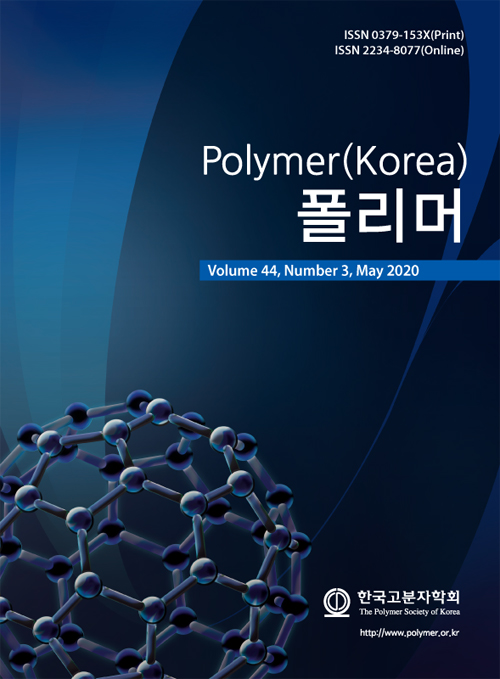- Evaluation of Icephobic and Dissipation Performance on Coating Materials for Preventing Overhead Transmission Line from Ice/Snow Damages
Hyongjoon Lee, You Sub Kim, Hui Jae Cho, Seungtae Oh*, Jaehwan Shim*, Youngsuk Nam*, Song Ho Sohn**, Yong Chan Jung**, Sang Chul Han**, and Soo Yeol Lee†

Department of Materials Science and Engineering, Chungnam National University, Daejeon 34134, Korea
*Department of Mechanical Engineering, Kyung Hee University, Yongin 17104, Korea
**KEPCO Research Institute, Daejeon 34056, Korea- 가공 송전선 빙설해 예방을 위한 코팅재의 결빙 방지 및 방열 성능 평가
이형준 · 김유섭 · 조희재 · 오승태* · 심재환* · 남영석* · 손송호** · 정용찬** · 한상철** · 이수열†

충남대학교 신소재공학과, *경희대학교 기계공학과, **한국전력공사 전력연구원
In this work, we manufactured
icephobic coating materials, consisting of aluminum pigment-added room
temperature vulcanized silicone rubber, by varying the particle size and type
of the aluminum pigment. From the measurements of contact angle and surface
energy, the coating with higher surface roughness revealed superior water
repellency. However, icephobic performance was inversely proportional to
surface roughness and hardness. The continuous allowable current application
test showed that the silicone rubber (SR) coating exhibited the highest heat
dissipation capacity due to its higher emissivity close to ~1. Furthermore, the
SR coating revealed the remarkable durability for the icephobicity in the
long-term period, as evidenced from the accelerated degradation test and cyclic
icing/de-icing test. The developed coating material broadens industrial
applicability as the icephobic coatings in transmission line. Moreover, it is
expected that the superior heat dissipation capability of the SR coating would
enhance the power efficiency in summer.
본 연구에서는 송전선 결빙으로 인한 피해를 최소화하고자
상온 경화형 실리콘 고무에 입자 크기와 혼합 배열을 달리한 알루미늄 안료를 첨가하여 결빙 방지 코팅재를 제조하였다. 접촉각과 표면에너지 측정을 통해 표면 거칠기가 높은 코팅재가 뛰어난 발수성을 가짐을 확인하였다. 하지만, 결빙 방지 성능은 표면 거칠기와 경도가 낮을수록 우수하였다. 연속허용전류 인가 실험 결과, 실리콘 고무 코팅재의 방열성능이 가장
우수하였으며, 이는 실리콘 고무의 복사율이 가장 컸기 때문이다. 또한
가속 열화 시험과 얼음 탈착/부착 반복 시험을 통하여 실리콘 고무 코팅재는 장기간 물성 변화 없이 우수한
결빙 방지 성능이 유지됨을 알 수 있었다. 본 연구를 통하여 개발된 코팅재는 송전선의 결빙 방지를 위해
충분히 사용될 수 있는 가능성을 보여주었으며, 특히 우수한 방열특성으로 인하여 송전선의 온도도 낮추어
주기 때문에 여름철 전력 효율을 높이는데도 크게 기여를 할 수 있을 것으로 생각된다.
Keywords: transmission line, icephobic coating, aluminum pigment, ice adhesion strength, heat dissipation
- Polymer(Korea) 폴리머
- Frequency : Bimonthly(odd)
ISSN 0379-153X(Print)
ISSN 2234-8077(Online)
Abbr. Polym. Korea - 2023 Impact Factor : 0.4
- Indexed in SCIE
 This Article
This Article
-
2020; 44(3): 342-348
Published online May 25, 2020
- 10.7317/pk.2020.44.3.342
- Received on Feb 4, 2020
- Revised on Feb 27, 2020
- Accepted on Feb 29, 2020
 Correspondence to
Correspondence to
- Soo Yeol Lee
-
Department of Materials Science and Engineering, Chungnam National University, Daejeon 34134, Korea
- E-mail: sylee2012@cnu.ac.kr









 Copyright(c) The Polymer Society of Korea. All right reserved.
Copyright(c) The Polymer Society of Korea. All right reserved.